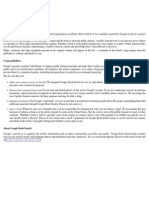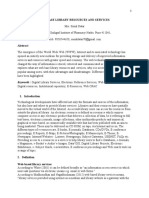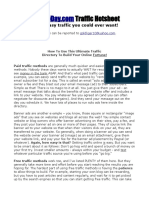HTML Interview Question
Uploaded by
nasima.tamboliHTML Interview Question
Uploaded by
nasima.tamboliWeb
1. What is HTTP?
HTTP stands for Hypertext Transfer Protocol. It's a fundamental protocol used for
communication on the World Wide Web.
2. What is the difference between HTTP and HTTPS?
HTTP (Hypertext Transfer Protocol) sends data between a user's browser and a website in plain
text, exposing it to potential interception. In contrast, HTTPS (Hypertext Transfer Protocol
Secure) encrypts this data using SSL/TLS, ensuring that sensitive information remains private
and secure, while also verifying the authenticity of the website, bolstering user trust.
3. When we open some websites, what is the order of loading HTML, CSS, and JS?
When opening a website, the browser loads HTML first to structure the page's content, then
fetches and applies CSS for styling, and finally retrieves and executes JavaScript to add
interactivity and dynamic features, with potential optimizations affecting the loading order for
improved performance.
Watch these two videos to understand all the concepts related to web and HTTP:
What Is Internet? | Frontend Bootcamp Hindi | Ep.00
Watch this before learning HTML | HTTP request and response | Frontend Bootcamp Hind…
HTML
1. What is HTML?
HTML stands for Hypertext Markup Language. It's a standard markup language used for
creating and structuring web pages.
Video Explanation: Learn Basic HTML by Making Project | Frontend Bootcamp Hindi | E…
2. Explain the difference between <div> and <span> elements.
<div> is a block-level container used to group and style elements, while <span> is an inline
container typically used for styling specific portions of text.
Video Explanation: Inline Vs Block Elements | Div & Span Tags Explained | Frontend Bo…
3. What is the purpose of HTML semantic elements?
Semantic elements (like <header>, <nav>, <footer>, <section>) provide meaning to the
structure of a web page, making it more accessible and search engine-friendly.
Video Explanation: Semantic Tags Explained | Frontend Bootcamp Hindi | Ep.04
4. What is the difference between Tags and Elements in HTML?
In HTML, "tags" are the markup symbols enclosed in angle brackets that define the structure of
"elements," which are complete units consisting of an opening tag, content, and a closing tag.
Elements represent different parts of a webpage and can hold text, images, links, and more,
while tags are the specific characters that create and delineate these elements within the HTML
code.
Video Explanation: What is the difference between Tags and Elements in HTML? | Front…
5. What are attributes in HTML?
Attributes in HTML are additional settings provided within the opening tag of elements. They
modify an element's behavior or appearance, such as specifying links, image sources, or styling
details.
Video Explanation: Global and Custom Attributes | Frontend Bootcamp Hindi | Ep.06
6. What is a form tag and how does it work?
The <form> tag in HTML is used to create a container for input elements like text fields,
checkboxes, radio buttons, and buttons. It's used to gather user input for submitting to a server.
The action attribute specifies where the data is sent, and the method attribute defines how it's
sent (usually "GET" or "POST"). When the user submits the form, the browser packages the
input data into an HTTP request according to the specified method and sends it to the
designated server URL.
Video Explanation: HTML Forms can do more than you might think | Frontend Bootcamp…
7. What is <!DOCTYPE> in HTML?
<!DOCTYPE> declaration in HTML specifies the type and version of the document being used,
helping browsers render the content correctly by using the appropriate standards and rendering
modes.
Video Explanation: HTML: The Missing Pieces | Frontend Bootcamp Hindi | Ep.08
8. What is the purpose of the meta tag in HTML?
The meta tag is used to provide metadata about the HTML document, such as character
encoding, viewport settings, authorship information, description, and more.
Video Explanation: HTML: The Missing Pieces | Frontend Bootcamp Hindi | Ep.08
9. What are the differences between the <canvas> and <svg> elements in HTML5?
The <canvas> and <svg> elements in HTML5 both enable graphics creation but differ in how
they achieve it. <canvas> is raster-based and relies on JavaScript for dynamic rendering,
suitable for complex animations and real-time graphics. <svg> is vector-based and uses XML
markup, offering resolution-independent graphics, easy manipulation via CSS and JavaScript,
and better accessibility.
10. What are HTML templates? How can they improve web performance?
HTML templates (like <template> tag) allow you to declare fragments of markup that aren't
rendered when the page loads. Describe how templates can enhance performance and provide
an example of their usage.
You might also like
- HTML & CSS For Beginners: Your Step by Step Guide to Easily HTML & CSS Programming in 7 DaysFrom EverandHTML & CSS For Beginners: Your Step by Step Guide to Easily HTML & CSS Programming in 7 Days4/5 (7)
- HTML Interview Questions and Answers For FreshersNo ratings yetHTML Interview Questions and Answers For Freshers3 pages
- HTML Css Questions Answers For Interview Students Competitive ExamsNo ratings yetHTML Css Questions Answers For Interview Students Competitive Exams29 pages
- Top 100 HTML Interview Questions and Answers 2023No ratings yetTop 100 HTML Interview Questions and Answers 202331 pages
- Bcom Web Programs Viva & E-Commerce VivaNo ratings yetBcom Web Programs Viva & E-Commerce Viva28 pages
- Comprehensive Hypertext Markup Language (HTML).: A Tutorial Guide to Editing and Developing a Responsive and Dynamic Website for Beginners.From EverandComprehensive Hypertext Markup Language (HTML).: A Tutorial Guide to Editing and Developing a Responsive and Dynamic Website for Beginners.No ratings yet
- Roldan Companies Inc. Announces New Documentary Film CYBER CRIME, Exploring The Impact of Digital CorruptionNo ratings yetRoldan Companies Inc. Announces New Documentary Film CYBER CRIME, Exploring The Impact of Digital Corruption2 pages
- Conferencepaperon LibraryresourcesandservicesNo ratings yetConferencepaperon Libraryresourcesandservices9 pages
- 365-Day: Https Cookie Stealing: Mike Perry Defcon 2007No ratings yet365-Day: Https Cookie Stealing: Mike Perry Defcon 200712 pages
- What Is The Difference Between A "Book" and A "Tome"? - English Language Learners Stack ExchangeNo ratings yetWhat Is The Difference Between A "Book" and A "Tome"? - English Language Learners Stack Exchange3 pages
- Using SOA With Web Services For Effective Integration of Hospital Information Systems Via An Enterprise Service BusNo ratings yetUsing SOA With Web Services For Effective Integration of Hospital Information Systems Via An Enterprise Service Bus7 pages
- Architectural Guidelines v1.9.2 - SmartStruxure SolutionNo ratings yetArchitectural Guidelines v1.9.2 - SmartStruxure Solution11 pages
- Kuwait University Computer Engineering Department Cpe 356: Computer Networks I Homework # 2 Due Wednesday May 5 Submit On Moodle by 2:00 PMNo ratings yetKuwait University Computer Engineering Department Cpe 356: Computer Networks I Homework # 2 Due Wednesday May 5 Submit On Moodle by 2:00 PM4 pages
- Taking Assessment in Mettl - Candidate Guide (Test Link)No ratings yetTaking Assessment in Mettl - Candidate Guide (Test Link)34 pages
- Developing Responsive Websites With Bootstrap and Jquery AssignmentNo ratings yetDeveloping Responsive Websites With Bootstrap and Jquery Assignment8 pages

























































































